
Are is a monotypic moth genus in the subfamily Arctiinae erected by Francis Walker in 1855. The type species is Are druryi, which is found on Jamaica. This species was described by Dru Drury in 1773 under the name Phalaena marginata, but this name is preoccupied by Phalaena marginataLinnaeus, 1758 and a new specific epithet, honouring Drury, was assigned in 1986.

Curoba is a monotypic moth genus in the subfamily Arctiinae erected by Francis Walker in 1865. It contains the single species Curoba sangarida, first described by Caspar Stoll in 1782, which is found in southern India and Sri Lanka.

Dactyloceras lucina is a species of very large moth of the family Brahmaeidae. It is found in central and west Africa, where it has been recorded from Equatorial Guinea, Ghana, Ivory Coast, Kenya, Sierra Leone, Uganda and Zambia. The species was first described by Dru Drury in 1782.
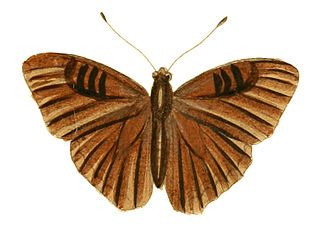
Euriphene doriclea, the Doriclea nymph, is a butterfly in the family Nymphalidae. It is found in Sierra Leone, Liberia, Ivory Coast, Ghana, Nigeria, Cameroon, Gabon, the Central African Republic, the Democratic Republic of the Congo and Uganda. The habitat consists of forests.

Euphaedra perseis, the Perseis mimic forester, is a butterfly in the family Nymphalidae. It is found in Guinea (Conakry), Sierra Leone, Liberia, Ivory Coast and western Ghana. It was first described by Dru Drury in 1773.

Colla rhodope is a moth in the family Bombycidae. It was described by Dru Drury in 1782. It is found from Mexico to Colombia, Ecuador and Brazil.
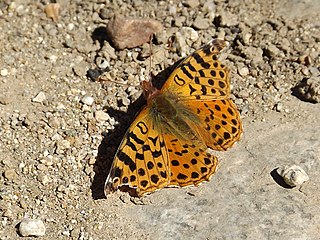
Yramea cytheris is a species of butterfly in the family Nymphalidae. It was first described by Dru Drury in 1773 from the Falkland Islands. In some systems it is included in genus Issoria.

Greta diaphanus, the Antillean clearwing, is a species of clearwing (ithomiine) butterflies, named by Dru Drury in 1773.

Antheua servula is a species of moth of the family Notodontidae. It was first described by Dru Drury in 1773 from Madras. It is also found in other parts of India, Sri Lanka and on Sumatra.
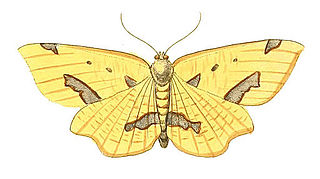
Xanthotype sospeta, the crocus geometer, is a species of moth in the family Geometridae. It was first described by Dru Drury in 1773 from Jamaica. It is also found in North America, where it has been recorded from Nova Scotia to southern British Columbia, south to Colorado and Georgia. The habitat consists of deciduous and mixedwood forests.

Electrostrymon pan is a butterfly of the family Lycaenidae. It was described by Dru Drury in 1773 from Jamaica.

Letis hercyna is a species of moth in the family Erebidae. It was first described by Dru Drury in 1773 from Jamaica.

Otroeda cafra is a species of moth in the tussock-moth subfamily Lymantriinae. It was first described by Dru Drury in 1782 from Sierra Leone, and is also found in Cameroon, DR Congo, Malawi, and Nigeria.

Otroeda nerina is a species of moth in the tussock-moth subfamily Lymantriinae. It was first described by Dru Drury in 1782 from Sierra Leone, and is also found in Cameroon, DR Congo, Gabon, Ghana and Nigeria.
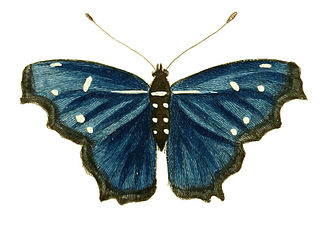
Myscelia orsis is a species of nymphalid butterflies native to Brazil. It was first described by Dru Drury in 1782.

Pseudobunaea alinda is a species of very large moths in the family Saturniidae. The species was first described by Dru Drury in 1782, and is found in Angola, Cameroon, Congo, DR Congo, Gabon, Guinea, Ivory Coast, Sierra Leone, and Tanzania.

Zamarada eucharis is a species of moth in the family Geometridae. It was first described by Dru Drury in 1782, from Sierra Leone. It is found in Ivory Coast, Ghana, Guinea, Liberia and Sierra Leone

Lobobunaea phaedusa is a species of very large moths in the family Saturniidae. It is found in much of sub-saharan Africa, where its host plants include African custard-apple, crown-berry, and Aframomum spp.
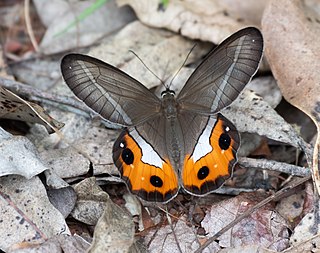
Pierella nereis is a butterfly species from the subfamily Satyrinae in the family Nymphalidae. It was first described by Dru Drury in 1782 from Brazil.
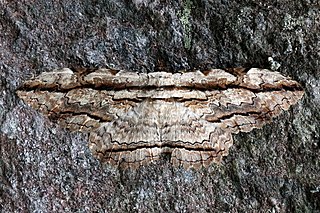
Thysania zenobia, the owl moth, is a species of moth in the family Erebidae. The species was first described by Pieter Cramer in 1776, and is native to North and South America and the Caribbean.



















